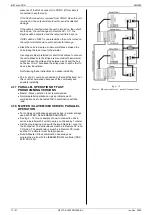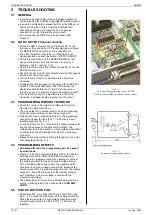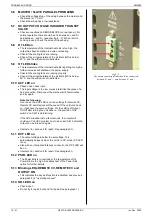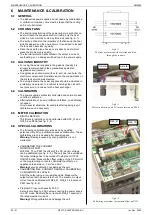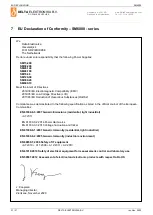
INSTALLATION
SM6000
16 / 21
DELTA ELEKTRONIKA B.V.
rev. Nov. 2020
4.13
BATTERY CHARGER
The CV / CC regulated power supplies are ideal battery
chargers. Once the output is set at the correct voltage the
battery will charge constantly without overcharging. This can
be useful for emergency power systems.
Protective measures
Use a CIRCUIT BREAKER in series in order to protect the
power supply from
accidental reverse connection
(see fig. 4
- 8).The circuit breaker should have a DC voltage rating twice
the battery voltage. Use the very fast type (Z), a type meant
for protecting semiconductors (see table 4 - 2).
The unit has a reverse diode in parallel with the DC output,
this diode and the wiring cannot withstand the thousands of
amperes supplied by a wrongly connected battery.
4.14
REMOTE SHUTDOWN
The Remote ShutDown can be operated on CON E by a
voltage of +4 V...+12 V or by a relay contact between Vref
and Remote ShutDown (pin 9 and 5) (see fig. 4 - 9).
When the unit is programmed with an optional PSC, a
software command can be used for Remote Shutdown.
In the Remote ShutDown condition, the RSD LED will be on.
The DCF LED, DCF status and the DCF relay will be off.
Important:
If the link from the Interlock connector (CON A)
has been removed, the RSD LED will be on, but in this
condition also the DCF LED, the DCF status and the DCF
relay will be on.
4.15
MASTER / SLAVE SERIES OPERATION
Connect output terminals and test system in
normal series
operation. Ensure that all DC power connections are reliable.
The voltage drop in the connecting leads between the units
should be kept < 10 mV.
Switch off all units. Connect units as shown in fig. 4 - 10.
To connect the slaves with the master via CON B and CON
C, use standard UTP cables (RJ45).
On all units put DIP switch 4 of SW1 in position DOWN to set
the units in M/S series mode.
After turning the units on again, the slaves will be in Remote
CV mode and the Keylock (see previous paragraph is
activated. This is because the unit automatically detects the
presence of the RJ45 connector in CON C (if this cable is
connected to another unit).
If the RJ45 connector is removed from CON C when the unit
is turned on, the DC output will shutdown to avoid accidental
damage.
If the cable is inserted when the unit is turned on, the DC
output shuts down, the unit changes to Remote CV / CC, the
Keylock will be activated and the output will turn back on.
If DIP switch 4 of SW1 is operated when the unit is turned on,
the DC output will shutdown to avoid accidental damage.
The maximum number of slaves is only limited by the
maximum total voltage of 600 V.
4.16
MASTER / SLAVE PARALLEL OPERATION
Note: Master / Slave parallel is not recommended for
more than 3 units, consult factory for using more than 3
power supplies in parallel.
First connect the DC power terminals and test system in
normal parallel
operation. Ensure that all power connections
are reliable.
Second, switch off all units. To connect the slaves with the
master via CON B and CON C, use standard RJ45
connectors according to fig. 4 - 11.
On all units put DIP switch 4 of SW1 in position UP to set the
units in M/S parallel mode. In this mode the DCF LED, DCF
relay and DCF status on the slaves are disabled because the
slaves are always in CC mode.
After turning the units on again, the slaves will be in Remote
CC mode and the Keylock (see previous paragraph 5) is
activated. This is because the unit automatically detects the
fig 4 - 9
Remote Shutdown with switch.
fig 4 – 10
Master / Slave series connections.
fig 4 - 11
Master / Slave parallel connections.
















